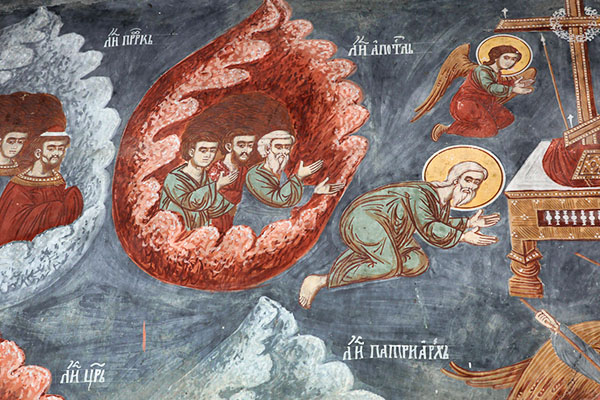The Church of Saint John the Forerunner in the village of Crkolez is situated on the old cemetery on a plateau overlooking the surrounding area. This village in Metohija is removed from the main traffic ways and some ten kilometers away from the town of Istok.
The oldest mention of the village and its church is found in the charter from 1400, issued by Princess Milica, nun Evgenija at the time, with her sons Stefan and Vuk, to the Athonite monastery of Saint Panteleimon. The charter confirms that Duke Novak and his wife Vidoslava donated the church in Crkolez “with the boundaries and privileges established at the time of Emperor Dušan.” This information can lead us to conclude that the church must have been built by 1355, the year of the death of Stefan Dušan. It is assumed that the church is an endowment of a nobleman from the time, most likely čelnik Radoslav. His name, together with his monastic name Jovan, is carved on a tombstone on the floor of the nave, in front of the royal door.
The church was renovated in 1650 and painted in 1673, with the donations of local inhabitants, whose names were inscribed on the west wall of the narthex. The leading Serbian painter of the time, Radul, was employed for the painting of the church. He left his name in the proskomedia, and it is assumed that he also painted the church icon screen during that time, as can be surmised from the formal characteristics of the royal doors still preserved in the church. Even though the village was burned down in World War II, the church remained intact. However, due to moisture and soil consolidation, extensive conservation and restoration works were carried out in 1970.
The church in Crkolez is a small single-aisled, barrel-vaulted structure with an apse at the east end that is five-sided on the outside. Built from cut rubble and tufa, marble for door jambs and windows, and stone slabs for the roof covering. The architectural decoration consists of a cornice, a semicircular arch of the south window, and a shallow lunette above the church entrance, surrounded by brick and marble ornaments in the shape of crosses and rosettes. During restoration works, on the west wall of the narthex, near the entrance, fragments of the original fourteenth-century wall painting were discovered.
The greatest significance and artistic value of the monument lie in the seventeenth-century frescoes painted by Radul. He was responsible for painting the Church of the Holy Cross of Ostrog monastery, a small church of Saint Nicholas in the Patriarchate of Peć. He also produced several icons for churches in Bijelo Polje, Sarajevo, the monastery of Morača, and others.
In the Church of Saint John the Forerunner in Crkolez, Radul adheres to established iconographic patterns from older Serbian art and, for the most part, standard programmatic choices in the painting of the church interior. He painted the cycles of Great Feasts and Passion of Christ in the nave, and an extensive cycle of the church patron, Saint John the Forerunner, in the narthex. In the altar area, he depicted representations customary for this part of the church– the Mother of God with Christ and the Archangels in the conch, Communion of the Apostles below, and the Liturgy of the archpriests in the lower zone.
In the narthex, the Last Judgment scene covers the entire surface of the west wall, with various groups of sinners depicted and designated with inscriptions in the vernacular.


